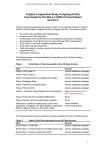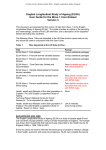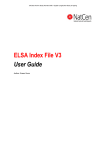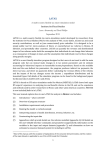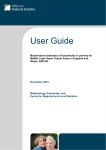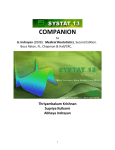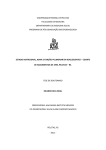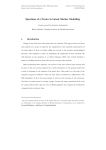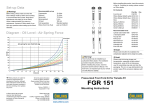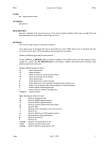Download Financial Derived Variables ELSA Waves 1
Transcript
Financial Derived Variables ELSA Waves 1 - 4 User Guide Author: Zoë Oldfield (Senior Research Economist, the Institute for Fiscal Studies) 1 Introduction.......................................................................................................................... 1 2 Data Description.................................................................................................................. 1 3 Type of Variables................................................................................................................. 2 4 Identifiers.............................................................................................................................. 3 5 Missing Values..................................................................................................................... 3 6 Equivalisation...................................................................................................................... 3 1 Introduction This document describes how to use the derived income and asset variables for ELSA Waves 1 to 4. For more information on the imputation procedures, please refer to the accompanying document (named “Financial Derived Variables Imputation Procedures, ELSA Waves 1 to 4”). A common feature of all financial variables in ELSA is the use of unfolding brackets. Each financial variable in ELSA is collected by initially requesting an exact answer and then following up with a series of what are referred to as “unfolding brackets”. Unfolding brackets operate by asking respondents who are unable or refuse to give an exact answer, a series of follow up questions designed to elicit a minimum and maximum number defining a range or “closed band” within which the value lies. Each financial variable in ELSA will therefore have a set of raw variables associated with it containing both the continuous and the bracketed information. For more details on this, see the Questionnaire. These variables are used to create a single variable that, after imputation, contains a continuous variable for almost every respondent.1 These variables are then used to derive summary variables for income and wealth. 2 Data Description The variables are labelled and the accompanying Excel spreadsheets (listed below) match the derived variables to their source variables and provides further information specific to particular variables. There is one spreadsheet for each wave of data. 5050_Wave_1_Financial_Derived_Variable_Relationships.xls 5050_Wave_2_Financial_Derived_Variable_Relationships.xls 5050_Wave_3_Financial_Derived_Variable_Relationships.xls 5050_Wave_4_Financial_Derived_Variable_Relationships.xls All monetary income flows are expressed as weekly equivalents and are current. ELSA collects information about current income (i.e. income in the last month) and, in order to obtain a longer term picture, income in the last year. All derivation of total income uses a current measure of income. Many of the variables are derived at the “benefit unit level”. This is a couple or a single person plus any dependent children they may have. These variables are suffixed “_BU”. Variables which have no suffix refer to the individual. Variables which have a “_P” suffix refer to the partner of that individual. Variables which have a “_HH” suffix refer to the household. Note that the “benefit unit” is different to a “financial unit”. A couple who keep their finances separate will be defined as two financial units and each will answer IA on their own behalf. For couples that keep their finances separate, we combine the information reported by each member of the couple to obtain a benefit unit definition of income and wealth. 1 We do not impute values for respondents who do not answer the entire Income and Assets module. User Guide 1 It should be noted that because IA is asked once per “financial unit” the income and wealth information for any individual may have been reported by that individual or their partner (see the User Guide for the ELSA Wave 1 Core Dataset for details). Users wishing to know which financial unit member answered questions from IA should use the variable called IAPID. 3 Type of Variables A) Variables ending in “I” (before the _BU/_P suffix), contain the imputed value or the actual value reported by the respondent. B) Variables ending in “T” (before the _BU/_P suffix) describe the type of imputation that took place. 0 Zero - value of zero reported so no imputation took place 1 Continuous - exact value reported so no imputation took place 2 Closed band - this type of income or wealth was imputed from an upper and lower bound (e.g. between £100 and £200) 3 Open band - this type of income or wealth was imputed from a lower bound but no upper bound (e.g. £100 or more) 4 Missing, positive - either (or both) members of the benefit unit reported that they have this type of income or wealth but they cannot (or refuse to) give us a value even after entering the unfolding brackets 5 Missing completely – neither member of the benefit unit can tell us if they have this type of income or wealth 7 Missing, has asset – this code is unique to assets. It occurs when the either member of the benefit unit reports that they have a particular asset but they cannot tell us any information about the income earned from that asset. 8 Missing, has some type of ISA – this code is unique to ISAs. It occurs when the benefit unit reports that they have an ISA but they cannot tell us which type (cash, shares, or life insurance) of ISA it is. C) Variables ending in “O” (before the _BU/_P suffix) store the number of observations used to impute the missing value. Note that when the number of observations is zero, an alternate imputation strategy was used and this variable is coded -2 (see the accompanying document, “Financial Derived Variables Imputation Procedures, ELSA Waves 1 to 4”, for more details). D) Summary variables. These are variables that sum different components of income and wealth. E) Variables beginning with “NI”. These are the imputation flags which accompany the summary variables. Because the summary variables use many different components of income and wealth and any of those components could have been imputed in some way, these variables describe how many of the components were imputed. Variables of the form NIvarname2_BU (where varname is the summary variable such as TOTINC) report how many components had a “type” of greater or User Guide 2 equal to 2 (i.e. closed band or worse). Variables of the form NIvarname3_BU report how many components had a “type” of greater or equal to 3 (i.e. open band or worse). Variables of the form NIvarname4_BU report how many components had a “type” of greater or equal to 4 (i.e. missing, positive or worse). 4 Identifiers In addition to the usual identifiers found in the main data (such as IDAUNIQ), there are two additional identifiers. These are COUPID and FUID. COUPID is an identifier which uniquely identifies couples. Each member of a couple has the same COUPID except where one member of that couple is in an institution. Single people have their own COUPID. Note that where someone is a member of a couple, but one member of that couple did not respond to the main survey, there will only be one observation for that couple in the ELSA data. FUID uniquely identifies financial units. Each respondent who answered IA has a unique FUID. 5 Missing Values There is one observation for each ELSA respondent in each of the financial derived variables datasets. However there are certain circumstances where we do not attempt imputation. More details on this are given in the “Financial Derived Variables Imputation Procedures, ELSA Waves 1 to 4” document. These observations are given a value of –999 for all sources of income and wealth The second type of missing value is reserved for the quantiles of income and wealth. Quantiles are calculated only for sample members and are weighted. Non-sample members are given a value of –998. Financial variables are not derived for individuals in institutions and these cases are assigned a value of –995. 6 Equivalisation Equivalisation is a way in which income can be adjusted to take account for differing household size. The equivalence scale used here is an OECD equivalence scale 2 and assigns a weight of 0.5 to second adults and dependent children aged 14 and over and a weight of 0.3 to children under 14 years of age. 2 See HAGENAARS, A., DE VOS, K. and ZAIDI, A. (1994), Poverty Statistics in the late 1980s, Eurostat, Luxembourg. User Guide 3 Financial Derived Variables Imputation Procedures ELSA Waves 1 - 4 Author: Zoë Oldfield (Senior Research Economist, the Institute for Fiscal Studies) 1 Introduction.......................................................................................................................... 1 2 Financial Information and Unfolding Brackets..................................................................1 3 Units of Observation for Imputation Purposes.................................................................1 4 Imputation............................................................................................................................ 2 5 Special Cases....................................................................................................................... 3 5.1 Benefit units with one non-responding partner....................................................................................................3 5.2 Benefit units where one or both partners are in institutions (applicable from Wave 2 onwards only).................4 6 Derivation of Quantiles........................................................................................................ 4 7 Cases where income and health is not imputed...............................................................5 1 Introduction This document describes the imputation procedures and any assumptions made in the derivation of the income and asset variables for ELSA Waves 1 to 4. Please see the accompanying User Guide for details on how to use to income and asset variables. 2 Financial Information and Unfolding Brackets A common feature of all financial variables in ELSA is the use of unfolding brackets. Each financial variable in ELSA is collected by initially requesting an exact answer and then following up with a series of what are referred to as “unfolding brackets”. Unfolding brackets operate by asking respondents who are unable or refuse to give an exact answer, a series of follow up questions designed to elicit a minimum and maximum number defining a range or “closed band” within which the value lies. Unlike conventional brackets, respondents are not presented with a list of ranges within which to place themselves. Instead, on entering the unfolding brackets, respondents are asked to say whether they have more, less or about a particular value. This question is repeated using different values (which will be a lower or higher number depending on the answer to the preceding question). The procedure stops at the point when either an upper or lower bound is provided, the respondent refuses or says “don’t know”, or the respondent places themselves in the top bracket. The unfolding bracket questions are randomly ordered for each respondent such that any possible anchoring effects from the procedure are averaged across the distribution, and the bracket values are selected on the basis of the density of the underlying financial variable. Unfolding brackets significantly reduce the number of observations for which we have no information at all on any one source of income or wealth. Nevertheless, because refusals and “don’t know” responses are accepted at any stage in the unfolding brackets, the data that we have are of variable type. Respondents provide either an exact amount, a “closed band” where both an upper and a lower bound are reported, an “open band” where respondents are able to provide a lower bound but cannot provide an upper bound (or alternatively place themselves in the top bracket which is open ended by design), missing but positive and missing completely. Missing but positive values arise when the respondent reports that they have a particular type of income or asset but are unable or refuse (even after proceeding through the unfolding brackets) to report how much they have. In a small number of cases, values are completely missing and this arises when respondents refuse to report or don’t know whether they have a particular type of income or asset. Completely missing values also arise in a small number of cases where respondents did not complete the housing module and/or the income and assets module (partial interviews). Where we have banded or missing information, imputation is used to obtain a value. The method of imputation is described in the remainder of this document. 3 Units of Observation for Imputation Purposes Financial information in ELSA is recorded in a number of different modules: Work and Pensions (WP), Income and Assets (IA) and Housing and Consumption (HO). WP is asked once per individual, IA is asked once per financial unit and HO is asked once per household. Single people and couples who report that they keep their finances together are defined as a single financial unit. However, couples who report that they keep their finances separate are defined as two separate User Guide 1 financial units. Within IA, for couples who keep their finances together (joint finance couples), some variables are identified separately for respondent and their spouse (so the financial respondent is asked separately “How much do you receive?” and “How much does your spouse receive?”) and some variables are collected jointly (so the financial respondent is asked “How much do you and your husband/wife/partner receive?”). This means that there are four different types of variables: a) Variables asked once per individual b) Variables asked once per financial unit and joint finance units are asked jointly how much each of them receive/have c) Variables asked once per financial unit but joint finance units are asked separately how much each of them receive/have d) Variables asked once per household For types a) and c), we impute values for separately for each individual. Type b) is imputed at the benefit unit level (i.e. once per benefit unit). A benefit unit is defined as a single person or a couple (regardless of whether they keep their finances separate or together). So for a couple who keep their finances separate, even though each of them answered IA separately, we impute a joint amount of each variable of type b). This is because there are insufficient observations of separate finance couples in order to impute separately for each member of these couples. We obtained a joint upper and lower bound of each variable of type b) by summing the upper and lower bounds of each member of the couple. Type d) variables are those relating to housing wealth. We attribute housing wealth to the person/people whose name the accommodation is in and their spouse. If there is more than one person whose name the accommodation is in and those people are in different benefit units, the housing wealth is divided equally across those benefit units. 4 Imputation The imputation procedure that we use is the conditional hot-deck. For each missing or banded case, this involves choosing a random observation from all observations with matching characteristics in a number of dimensions (the conditioning variables) and, where we have banded information, with income or wealth within the same range. The level of wealth or income from the observation that is picked at random is then assigned to the missing or banded case. For variables that are imputed at the benefit unit level, the conditioning variables that we use are broad age band (50 to state pension age, state pension age to 75 and 75+; for couples the age of the male is used or for single-sex couples, the age of the oldest is used), and benefit unit type (couple, single man or single woman). For variables that are imputed at the individual level, the conditioning variables we use are age and gender. The conditioning variables are used in addition to the upper and lower bounds provided by the respondent. For a small number of variables we use additional or alternative characteristics that are predictive of the missing values. These variables are as follows: Current value of main home (HSVALI_BU): This is imputed using number of rooms, region and the highest educational level of the householders (where a householder is defined as someone whose name the accommodation is in). Where number of room is missing, the conditioning variables are household size, region and highest educational level of the householders. User Guide 2 Current mortgage debt (HDEBTI_BU): This is imputed using tertile of current house value (imputed where necessary) and number of years left to pay on the mortgage. For those who do not report the number of years left to pay on the mortgage, mortgage debt is imputed conditional on the maximum age of the householders. Note that we impute mortgage debt unconditionally on the type of mortgage. Endowment mortgage debt is collected via two questions: the outstanding balance of the mortgage not including the value of the endowment and how much the endowment policy is worth. We compute an upper and lower bound for the net mortgage debt and impute unconditionally on the type of mortgage. The conditioning variables are used for imputation of missing values, closed bands and open bands except where the open band arises due to the respondent reporting that they have/receive an amount in the top bracket which is open by design. In these cases, because the brackets are designed so that only around 1 per cent of the distribution falls into the top brackets, there are very few observations from which to impute and so we use unconditional hot-deck imputation for these cases. In the few cases where there are no observations from which to impute missing values, for closed bands, the mid-point of the band is used and for open bands, twice the lower bound is used. 5 Special Cases There are two types of cases where imputation is more complicated. These are: a) Benefit units with one non-responding member; b) Benefit units where one or both partners are in institutions (applicable from Wave 2 onwards only) The imputation procedures for these special cases are described in this section. 5.1 Benefit units with one non-responding partner Ultimately what we wish to derive is benefit level income and wealth. In some benefit units, only one member of that benefit unit responds to the survey and one problem is how to deal with nonresponding spouses. Most of the income information is collected at the “financial unit” level. This means that if a couple reports that they keep their finances jointly, the responding member of that couple will answer some questions about income and assets on behalf of the couple. In these benefit units, nonresponding spouses do not pose a problem when imputing variables that are collected at the financial unit level. The majority of benefit units where there is a non-responding spouse do keep their finances together. However, some variables (namely, those in WP) are asked at the individual level. In order to measure total income of the benefit unit, we need to measure the earnings of both members of that unit. Information on earnings is collected at two points in the ELSA survey. Detailed information is collected in WP at the individual level and then a summary question is asked in IA at the financial unit level. In the derivation of total income, the detailed information on earnings collected at the individual level is used. For benefit units where one member did not respond, even User Guide 3 if that unit keep their finances together we have missing information on earnings for the nonresponding spouse. In Wave 1, we do not know the labour market status of the non-responding spouse. However, the age of the non-responding spouse is recorded and the approach we take in imputing earnings for the non-responder is to assume that non-responders over state pension age have zero earnings. In Wave 2 onwards, we do know the employment status of the non-responding spouse as this information is collected in the household grid from the other responding members of the household. For those under state pension age, we use quantiles of the summary measure of earnings (joint earnings of the couple in the past year) recorded in IA as an additional conditioning variable for the purposes of imputing earnings of the non-responding spouse For couples with one non-responding member who keep their finances separate the responding member of the couple answers all questions on income and assets on their own behalf and not on behalf of the couple. Because of the lack of information on the non-responding member of these couples we do not impute income or asset measures for these couples. See below for other cases where we do not impute. 5.2 Benefit units where one or both partners are in institutions (applicable from Wave 2 onwards only) From Wave 2 onwards, ELSA respondents were followed into institutions (although data is only available on institutions respondents from Wave 3 onwards). This raises additional issues for imputation and these are described here. We do not derive income and wealth for anyone who was interviewed in an institution. The conceptual issues surrounding allocating these individuals’ income and wealth (especially where they have a partner who remains in the private household sector) are complex, and we do not attempt to impute financial variables for these individuals – their values are set to –995 for all derived variables. Researchers interested in the institutional sector can use the raw data from these individuals to derive their own income and wealth measures. Couples where one member of a couple is in an institution are each given a different COUPID. However, their partners can still be identified using the core data, using the variable PID. Partners of individuals in institutions (who themselves remain in the private household sector) who report that they keep their finances separate from their partner are treated as single individuals for the purposes of deriving financial variables. For couples who report that they keep their finances together, we assign the partner lives in the private household sector all the income reported by them for themselves and their partner. This is based on the assumption that despite the fact that one of them is in an institution, the partner remaining at home does benefit from the partner’s income. Where imputation is required for joint finance couples where one of them is in an institution, we do not condition on whether they are a member of couple. Given the additional complex issues surrounding couples where one member is in an institution, careful consideration should be given to the treatment of these couples for the purposes of analysis. 6 Derivation of Quantiles Quantiles are weighted and are derived only for sample members since this is the representative part of the ELSA sample. Non-sample members are assigned a value of User Guide 4 –998. 7 Cases where income and health is not imputed There are some cases for which we do not impute income and wealth. These are cases where the extent of the non-response means that we do not have enough information to carry out imputation in a reliable way. These cases are assigned a value of –999. These cases are detailed below. Income and wealth from IA is not imputed for: 1. Single people who do not answer IA; 2. Joint finance couples where neither partner answered IA (either because they did not respond to the whole survey or because they did not answer the IA module); 3. Separate finance couples where at least one partner did not answer IA Income from WP is not imputed at the benefit unit level for: 1. Separate finance couples where one partner did not respond. User Guide 5












